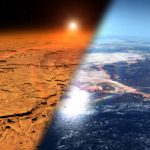Chemical reactions high in Mars’ atmosphere rip apart water molecules0
- From Around the Web, Space
- November 21, 2020
The process, which takes four hours on average, helps explain why Mars loses water so fast

The process, which takes four hours on average, helps explain why Mars loses water so fast

Dust storms triggered the loss of massive amounts of water from high in Mars’ atmosphere, according to new analysis of data collected by NASA’s MAVEN spacecraft. For the first time, water has been tracked all the way into Mars’ upper atmosphere, say the authors of a new paper appearing in the journal Science.

If ever there might be a suitable world that Marvel’s Jade Giant might want to settle down on, it’s this spooky, green-tinted rendering of Mars’ nightside atmosphere delivered by the enterprising folks at NASA.

NASA’s Mars Atmosphere and Volatile EvolutioN (MAVEN) spacecraft has detected sporadic ‘layers’ and ‘rifts’ in the ionosphere — the electrically charged part of the upper atmosphere — of Mars.

High above the surface of Mars, winds circulate from dayside to night, and the air undulates as it passes over mountains and valleys far below, a new study shows.

On Mars, the atmospheric pressure is around 0.6% of Earth’s. Any liquid water on the surface would very quickly evaporate or freeze. One of the challenges of terraforming the Red Planet is to increase its atmospheric pressure. The Martian polar caps, minerals, and soil could all provide sources of carbon dioxide and water to thicken the atmosphere. But a new study in the journal Nature Astronomy finds that processing all sources available on the planet would only increase the pressure to about 7% that of Earth, far short of what is needed.

Martian dust storms play a role in the ongoing process of gas escaping from the top of the planet’s atmosphere, according to a new study using observations by NASA’s Mars Reconnaissance Orbiter (MRO).

Mars has an invisible magnetic ‘tail’ that is twisted by interaction with the solar wind, according to new research using data from NASA’s MAVEN spacecraft.

A solar event on September 11, 2017 sparked a global aurora on the Red Planet more than 25 times brighter than any previously seen by NASA’s MAVEN (Mars Atmosphere and Volatile Evolution) spacecraft. The event also produced radiation levels on the Martian surface more than double any previously measured by NASA’s Curiosity rover.

More than 150 years after it happened, scientists are still taking about the Carrington Event—a solar storm in Sept. 1859 that sparked Northern Lights as far south as Cuba and sprayed the entire surface of Earth with high energy radiation.